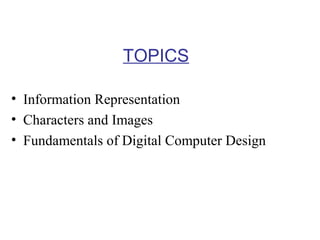
Compgenerations pented
- 1. TOPICS • Information Representation • Characters and Images • Fundamentals of Digital Computer Design
- 2. Information Representation • All information must be rendered into binary in order to be stored on a computer. • Besides numbers, almost all applications must store characters and string information. • Images are pervasive in today’s internet world and must be rendered in binary to be handled by internet browsers.
- 3. Character Representation • ASCII – PC workstations • EBCDIC – IBM Mainframes • Unicode – International Character sets
- 4. ASCII • ASCII • Expanded name American Standard Code for Information Interchange • Area covered 7-bit coded character set for information interchange • Characteristics/description Specifies coding of space and a set of 94 characters (letters, digits and punctuation or mathematical symbols) suitable for the interchange of basic English language documents. Forms the basis for most computer code sets
- 5. ASCII
- 6. EBCDIC • EBCDIC • Expanded name Extended Binary Coded Decimal Interchange Code • Proprietary specification developed by IBM • Characteristics/description A set of national character sets for interchange of documents between IBM mainframes. Most EBCDIC character sets do not contain all of the characters defined in the ASCII code
- 7. EBCDIC • EBCDIC • Usage Not much used outside of IBM and similar mainframe environments. When transmitting EBCDIC files between systems care needs to be taken to ensure that the systems are set up for the relevant national code set.
- 8. EBCDIC
- 9. UNICODE Unicode can represent all of the world's characters in modern computer use, including technical symbols and special characters used in publishing. Because each Unicode code value is 16 bits wide, it is possible to have separate values for up to 65,536 characters. Unicode-enabled functions are often referred to as "wide-character" functions.
- 10. UNICODE Note that the implementation of Unicode in 16-bit values is referred to as UTF-16. For compatibility with 8- and 7-bit environments, UTF-8 and UTF7 are two transformations of 16-bit Unicode values. For more information, see The Unicode Standard, Version 2.0.
- 12. Devices that comprise a computer system Monitor (output) Speaker (output) System unit (processor, memory…) Printer (output) Scanner (input) Keyboard (input) Mouse (input) Storage devices (CD-RW, Floppy, Hard disk, zip,…)
- 13. What does a Computer Do? • Computers can perform four general operations, which comprise the information processing cycle. • Input • Process • Output • Storage
- 14. What are the Primary Components?
- 15. What are the Primary Components? • Input devices. • Central Processing Unit (containing the control unit and the arithmetic/logic unit). • Memory. • Output devices. • Storage devices.
- 16. What are the Primary Components? Input devices. • Keyboard. • Mouse
- 17. What are the Primary Components? Keyboard. • The most commonly used input device is the keyboard on which data is entered by manually keying in or typing certain keys. A keyboard typically has 101 or 105 keys.
- 18. What are the Primary Components? Keyboard.
- 19. What are the Primary Components? Mouse • Is a pointing device which is used to control the movement of a mouse pointer on the screen to make selections from the screen. A mouse has one to five buttons. The bottom of the mouse is flat and contains a mechanism that detects movement of the mouse.
- 20. What are the Primary Components? Mouse
- 21. What are the Primary Components? The Central Processing Unit • The central processing unit (CPU) contains electronic circuits that cause processing to occur. The CPU interprets instructions to the computer, performs the logical and arithmetic processing operations, and causes the input and output operations to occur. It is considered the “brain” of the computer.
- 22. What are the Primary Components? The Central Processing Unit
- 23. What are the Primary Components? Memory • Memory also called Random Access Memory or RAM (temporary memory) is the main memory of the computer. It consists of electronic components that store data including numbers, letters of the alphabet, graphics and sound. Any information stored in RAM is lost when the computer is turned off.
- 24. What are the Primary Components? Memory • Read Only Memory or ROM is memory that is etched on a chip that has start-up directions for your computer. It is permanent memory.
- 25. What are the Primary Components? Memory
- 26. What are the Primary Components? Memory
- 27. What are the Primary Components? Look inside your computer RAM BANK CPU
- 28. What are the Primary Components? Out Put Devices • Output devices make the information resulting from the processing available for use. The two output devices more commonly used are the printer and the computer screen. • The printer produces a hard copy of your output, and the computer screen produces a soft copy of your output.
- 29. What are the Primary Components? Out Put Devices
- 30. What are the Primary Components? Out Put Devices
